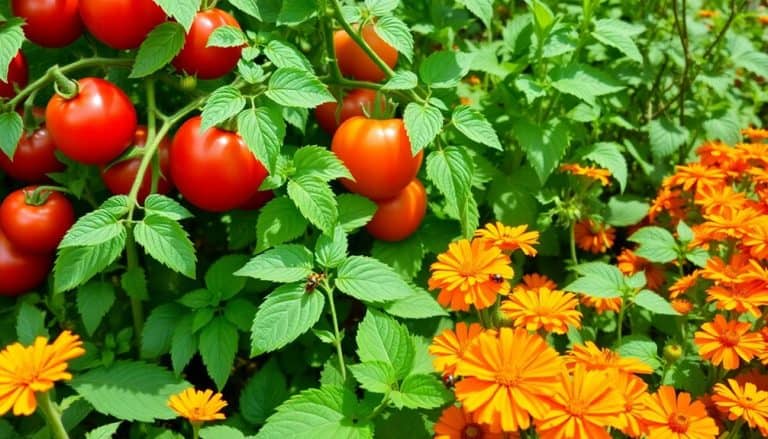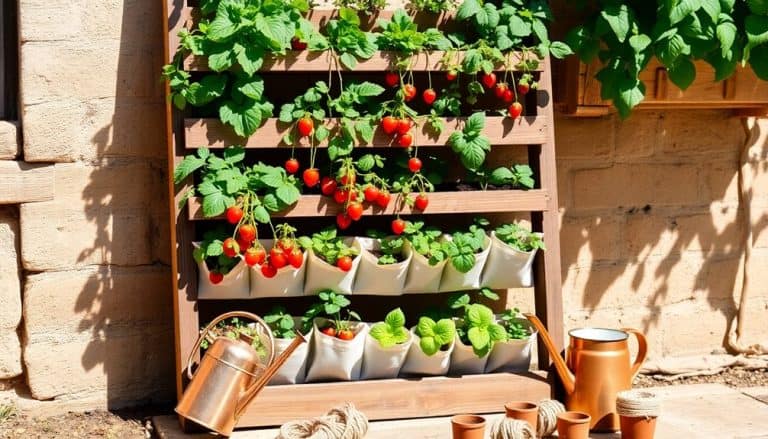This website contains affiliate links. Some products are gifted by the brand to test. As an Amazon Associate, I earn from qualifying purchases. The content on this website was created with the help of AI.
Your 2024 garden success depends on strategic month-by-month planning aligned with local climate zones. You’ll need to monitor soil temperatures, maintaining 40°F (4°C) minimum for cold-hardy crops, and implement succession planting at 2-3 week intervals. Start by conducting pH analysis (aim for 6.0-6.8) and amending soil with organic matter for ideal nutrient uptake. Install protective measures like row covers (1.5-oz agricultural fabric) and high tunnels to extend your growing season. Deploy drip irrigation systems with zone control, and maintain soil moisture at 40-60% water holding capacity. The thorough seasonal blueprint guarantees maximum yields across all four quarters.
Key Takeaways
- Start cold-hardy crops like kale and spinach when soil temperatures reach 40°F, typically in early spring months.
- Plant warm-season vegetables in 2-3 week intervals starting after last frost date for continuous harvests.
- Monitor soil moisture daily and maintain proper pH levels between 6.0-6.8 throughout the growing season.
- Install seasonal protection systems like row covers and cold frames to extend growing seasons into winter months.
- Implement crop rotation and succession planting strategies to maximize garden productivity across all twelve months.
Early Spring Garden Planning
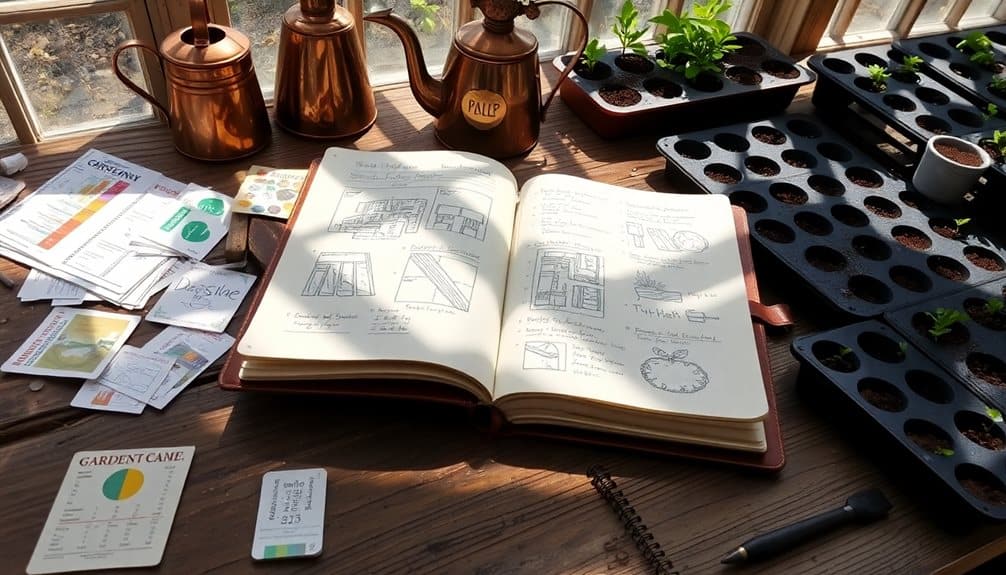
As winter’s grip loosens, early spring garden planning requires meticulous attention to soil temperatures and frost dates. You’ll need to monitor soil temperatures reaching 40°F (4°C) consistently before initiating your cool-season crop cultivation. Calculate your region’s last frost date using historical climate data and USDA hardiness zone parameters.
Begin soil preparation by conducting pH testing and amendments. You’ll want to incorporate organic matter when soil isn’t waterlogged, targeting a friable texture with adequate drainage. Test nitrogen, phosphorus, and potassium levels to determine specific fertilization needs for your intended crops. Using premium potting soil can significantly improve seedling development and root health.
Start cold-hardy cultivars indoors 6-8 weeks before transplanting. Focus on Brassicaceae family members like Brassica oleracea varieties and Beta vulgaris species. You’ll need to implement proper hardening-off protocols, gradually exposing seedlings to outdoor conditions over 7-10 days.
Create detailed succession planting schedules, accounting for germination rates and maturation periods. Document soil temperature readings, precipitation levels, and frost patterns. You’ll maximize growing potential by installing season-extension devices like cold frames or floating row covers, maintaining ideal microclimate conditions for early spring plantings.
Preparing Your Growing Space
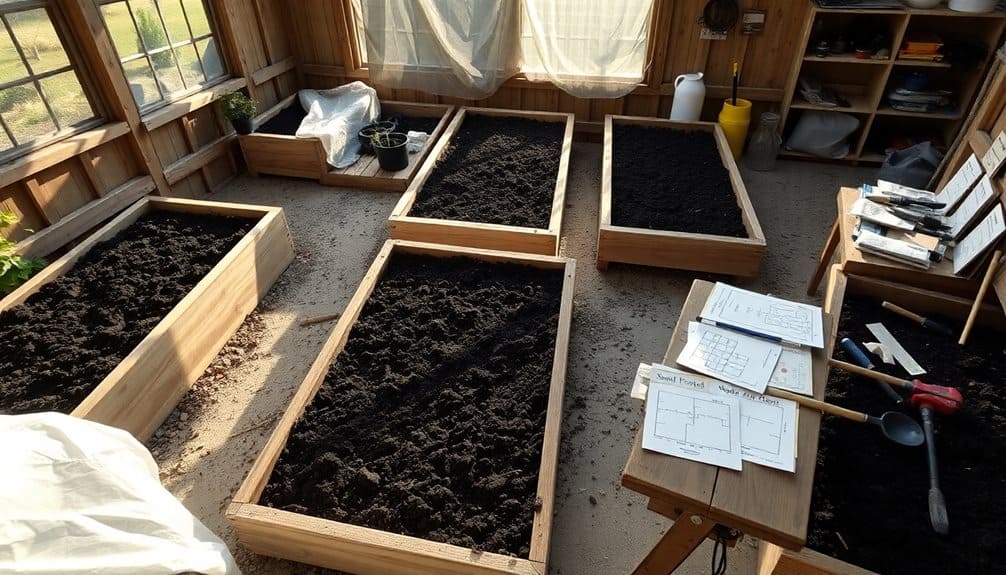
Properly preparing your growing space begins with a thorough site assessment evaluating solar exposure patterns, air circulation dynamics, and existing vegetation. You’ll need to analyze soil composition through pH testing, nutrient analysis, and structural evaluation to determine necessary amendments. Document your findings in a site plan that includes microclimates and drainage patterns.
Clear the designated area of debris, weeds, and unwanted vegetation, ensuring complete root removal of perennial weeds. Till or double-dig the soil to a depth of 12-18 inches, incorporating organic matter such as composted materials at a ratio of 30% by volume. Level the area while maintaining a 1-2% grade for proper drainage.
Install hardscaping elements like irrigation systems, raised beds, or trellises before soil preparation’s final phase. Establish defined paths and growing zones using permaculture zoning principles. Apply a 3-4 inch layer of mulch to suppress weed growth and retain soil moisture. If you’re implementing no-till methods, lay cardboard or landscape fabric beneath organic mulch layers. Complete soil preparation at least two weeks before your intended planting date to allow amendments to integrate and beneficial microorganisms to establish. Consider using soil test kits to monitor nutrient levels throughout the growing season for optimal plant health.
First Plantings of the Season
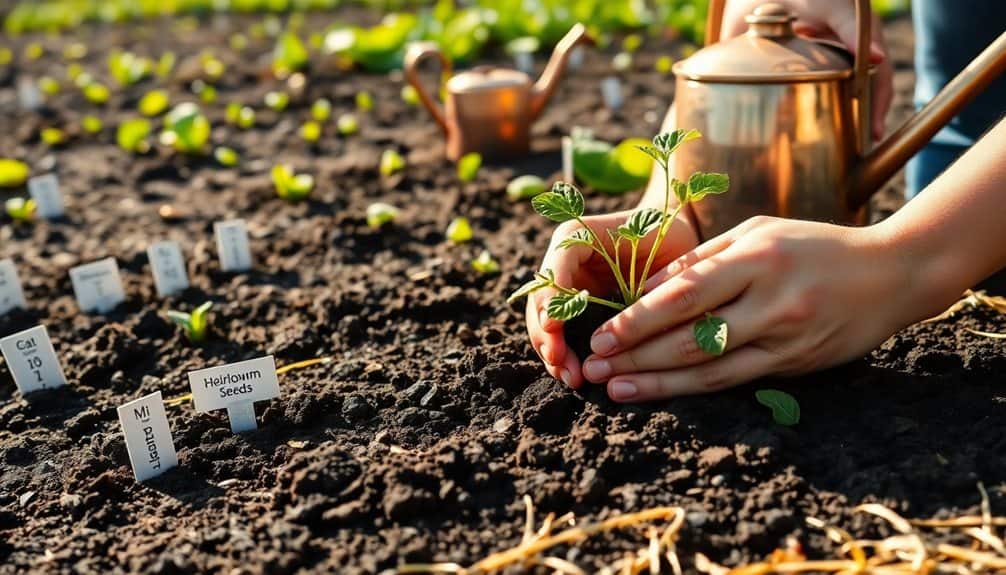
When soil temperatures reach 40°F (4°C), you’ll want to kick off the growing season with cold-hardy crops that thrive in early spring conditions. Begin with Brassicaceae family members like kale (Brassica oleracea var. sabellica), spinach (Spinacia oleracea), and snow peas (Pisum sativum var. saccharatum), which can withstand light frost and germinate in cool soil.
Direct-sow root vegetables such as radishes (Raphanus sativus) and carrots (Daucus carota) once soil can be worked. Plant alliums, including onion sets (Allium cepa) and garlic (Allium sativum), which establish strong root systems in cool conditions. You’ll achieve ideal germination by maintaining consistent soil moisture with row covers or cold frames.
For leafy greens, sow successive plantings of lettuce (Lactuca sativa) varieties and Swiss chard (Beta vulgaris var. cicla) at 10-day intervals. These crops prefer soil pH between 6.0 and 6.8. Install floating row covers to protect seedlings from temperature fluctuations and early-season pests. Monitor soil temperature using a probe thermometer, and don’t forget to harden off any greenhouse-started transplants before moving them to outdoor beds. Consider using Bokashi composting method to enrich your soil with fermented organic matter before planting your first crops.
Summer Crop Management
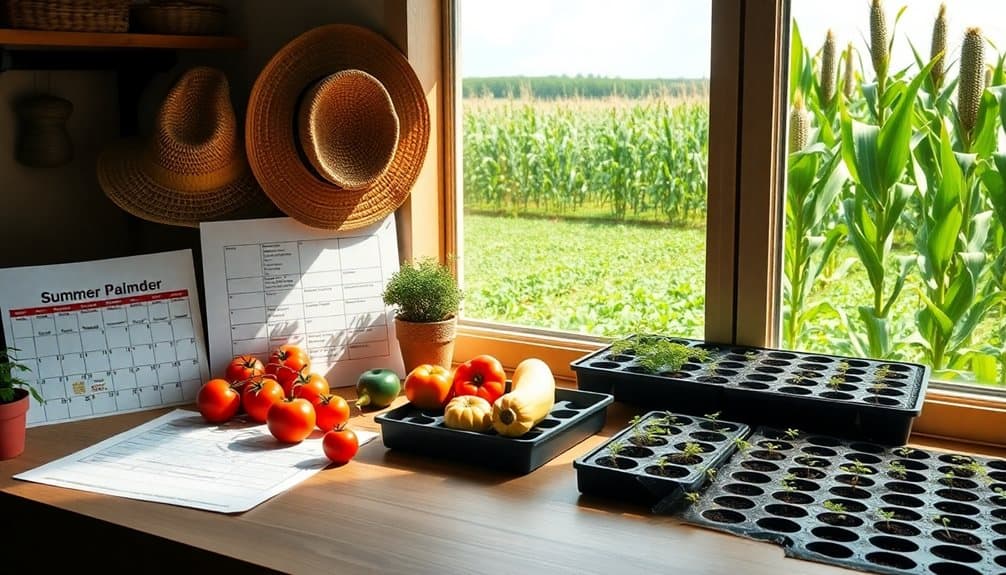
Throughout the peak growing season, you’ll need to implement extensive management strategies for warm-season crops like tomatoes (Solanum lycopersicum), peppers (Capsicum annuum), and cucurbits. Monitor soil moisture levels daily, maintaining consistent irrigation to prevent blossom end rot and fruit splitting. You’ll want to keep soil moisture at 80% field capacity during fruiting stages.
Implement integrated pest management protocols by scouting for common pests like aphids (Aphididae), hornworms (Manduca quinquemaculata), and squash vine borers (Melittia cucurbitae). Install floating row covers and deploy beneficial insects as biological controls. You’ll need to prune indeterminate tomatoes weekly, removing suckers to maintain airflow and redirect nutrients to fruit production.
Apply supplemental fertilization every 14-21 days using a balanced NPK ratio of 5-5-5 during vegetative growth, switching to 3-5-7 during fruit set. Monitor nighttime temperatures, as fruit set becomes inhibited above 75°F (24°C). Install shade cloth when daytime temperatures exceed 95°F (35°C) to prevent sun scald and maintain photosynthetic efficiency. Remove any diseased foliage showing signs of early blight (Alternaria solani) or powdery mildew (Erysiphaceae) promptly to prevent spread. Consider installing a drip irrigation system that can save up to 80% on water consumption while providing consistent moisture to your plants.
Succession Planting Strategies

Successful succession planting requires strategic timing of crop installations at 2-3 week intervals to maintain continuous harvests. You’ll need to calculate your frost dates, growing periods, and maturation cycles to optimize your planting schedule. Fast-maturing crops like leafy greens, radishes, and bush beans are ideal candidates for succession planting.
To implement an effective succession strategy, you’ll want to divide your garden into segments, rotating crops through designated zones while maintaining soil fertility. Calculate your last spring frost date and first fall frost date to determine your growing window. You’re looking at approximately 15-20 plantings throughout the season for quick-growing vegetables like lettuce and spinach.
For maximum efficiency, you’ll need to incorporate crop-specific factors: germination temperatures, days to maturity, and seasonal growth rates. Don’t forget to factor in declining day length after the summer solstice, as autumn plantings require additional time to mature. You can extend your growing season by utilizing row covers, cold frames, and high tunnels, enabling year-round succession planting in many climate zones.
Consider using raised garden beds for optimal drainage and soil quality control, which can significantly improve your succession planting success rates.
Fall Garden Essentials
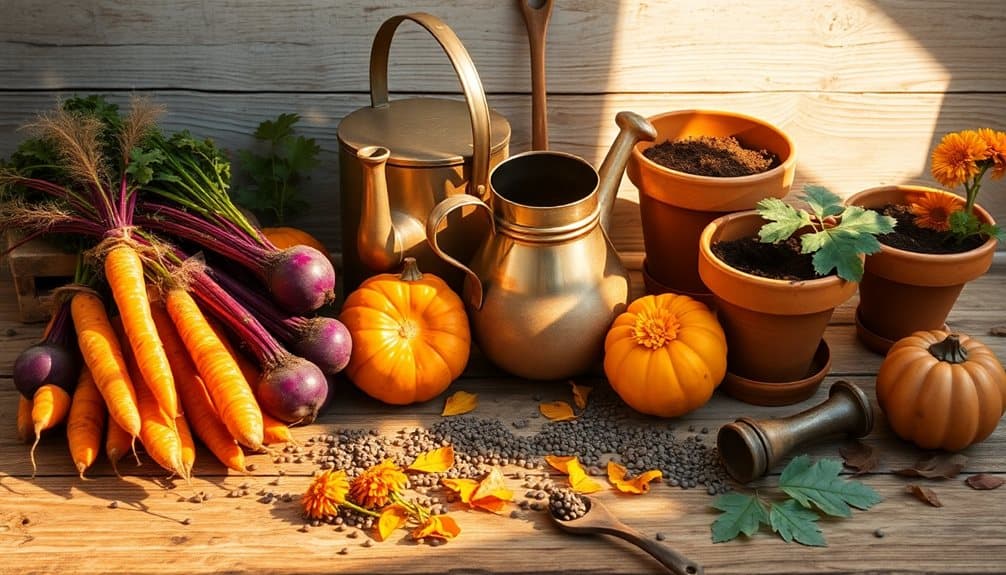
Planning your fall garden requires careful selection of cold-hardy cultivars and precise timing calculations based on your first frost date. You’ll need to determine your USDA hardiness zone and subtract the days-to-maturity from your area’s average first frost to establish ideal sowing dates.
Focus on Brassica varieties like ‘Winterbor’ kale, ‘January King’ cabbage, and frost-tolerant cultivars of Brussels sprouts. These crops develop enhanced flavor after exposure to cold temperatures due to increased sugar concentration in their tissues. Plant root vegetables including ‘Merlin’ carrots and ‘Hakurei’ turnips, which can withstand temperatures down to 20°F (-6°C).
You’ll need to implement cold protection strategies, including row covers with 1.5-oz agricultural fabric and cold frames maintaining soil temperatures 10-15°F above ambient conditions. Apply 2-3 inches of organic mulch to regulate soil temperature and moisture. Monitor soil pH, maintaining 6.0-6.8 for ideal nutrient uptake, and incorporate slow-release organic fertilizers with an N-P-K ratio of 5-5-5. Install drip irrigation beneath mulch to guarantee consistent moisture levels during establishment.
Winter Garden Preparation
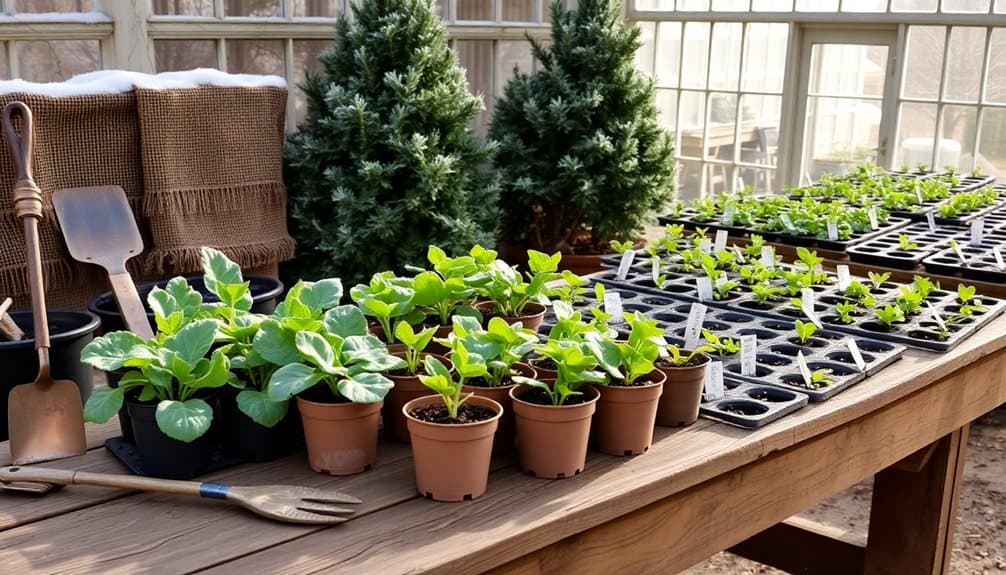
Winter’s approach demands strategic preparations to fortify your garden against freezing temperatures and harsh conditions. You’ll need to implement critical frost protection measures, including the installation of cold frames, row covers, and thermal mulching systems. Begin by conducting a soil pH analysis and amending with organic matter to maintain ideal nutrient availability during dormancy.
Apply a 3-4 inch layer of arborist wood chips or straw mulch around perennial root zones, ensuring the crown remains uncovered to prevent rot. You’ll want to install windbreaks using burlap screens oriented to block prevailing winter winds. Protect vulnerable shrubs with anti-desiccant sprays and wrap trunks with commercial tree guards to prevent sunscald and rodent damage.
Drain and insulate irrigation systems, storing temperature-sensitive components indoors. Monitor soil moisture levels, as winter desiccation can damage root systems during freeze-thaw cycles. Install temperature monitoring devices to track microclimatic variations. For winter vegetable production, construct polytunnels with proper ventilation systems and thermal mass features. Remove diseased plant material and sterilize tools to prevent pathogen overwintering. These measures will greatly enhance your garden’s winter survival rate and spring recovery potential.
Year-Round Growing Tips
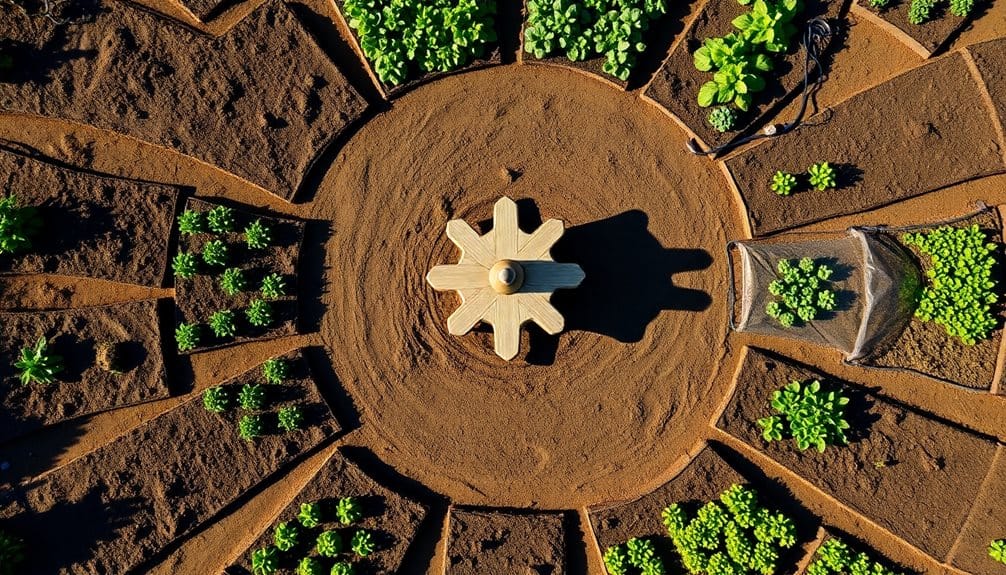
Throughout each season, effective cultivation requires a systematic approach to photoperiod management, soil fertility maintenance, and microclimate enhancement. You’ll need to monitor day length carefully, adjusting supplemental lighting to maintain ideal photoperiods for your crops’ vegetative and reproductive phases.
Maintain soil health by implementing a rotating nutrient management strategy. You’ll want to conduct quarterly soil tests to monitor pH, electrical conductivity, and macro/micronutrient levels. Apply amendments based on crop-specific requirements and seasonal variations in nutrient uptake. During active growth periods, you should maintain soil moisture at 40-60% water holding capacity.
Create microclimates using row covers, cold frames, and high tunnels to extend growing seasons. You’ll need to monitor ambient temperature, relative humidity, and soil temperature using data loggers. Install drip irrigation systems with zone control to enhance water distribution. During extreme weather events, deploy protective measures like shade cloth (30-50% density) in summer and frost protection fabrics (1.5-2.0 oz/yd²) in winter. Maintain proper air circulation to prevent fungal diseases, using oscillating fans in enclosed spaces and appropriate plant spacing outdoors.
Frequently Asked Questions
How Do You Prevent Animals From Destroying Newly Planted Seedlings?
In the epic battle between gardener and critter, you’ll need multiple defensive strategies. Install physical barriers like hardware cloth or floating row covers directly over seedlings. Deploy ultrasonic repellent devices and motion-activated sprinklers around the perimeter. You can also apply organic deterrents like blood meal, predator urine, or capsaicin spray. For persistent pests, construct raised beds with protective screening or electrified fencing.
Which Companion Plants Can Help Naturally Deter Common Garden Pests?
You’ll find robust pest control through strategic companion planting. Plant marigolds (Tagetes spp.) to repel nematodes and aphids, while nasturtiums (Tropaeolum majus) act as trap crops for cabbage moths. Incorporate aromatic herbs like basil (Ocimum basilicum) to deter mosquitoes and flies, and lavender (Lavandula angustifolia) to repel many garden pests. Plant catnip (Nepeta cataria) to ward off Japanese beetles, and alliums to protect against carrot flies.
Are Hydroponic Systems More Cost-Effective Than Traditional Soil Gardening?
While hydroponic systems require higher initial investment for equipment like pumps, reservoirs, and nutrient delivery systems, you’ll typically see 20-30% faster growth rates and up to 3x higher yields compared to soil cultivation. You can save on water usage (up to 90% less), eliminate weeding costs, and maximize growing space. However, you’ll need to factor in ongoing expenses for electricity and hydroponic nutrients when calculating long-term cost-effectiveness.
What’s the Best Way to Preserve Excess Harvest for Year-Round Use?
Picture your kitchen counter overflowing with fresh produce, waiting to be preserved. You’ll want to employ multiple preservation methods: dehydration at 135°F (57°C) for fruits and herbs, water bath canning at pH ≤4.6 for high-acid vegetables, and pressure canning at 240°F (116°C) for low-acid produce. For ideal nutrient retention, you can also blanch vegetables before flash-freezing at 0°F (-18°C) in vacuum-sealed bags.
How Do Different Moon Phases Affect Plant Growth and Harvest Timing?
The moon’s gravitational pull affects soil moisture and plant sap flow, with studies showing enhanced germination during the waxing phase. You’ll find root crops perform better when planted during the moon’s waning phase, while above-ground crops thrive when sown during waxing phases. The full moon’s increased gravitational pull raises groundwater levels, making it ideal for harvesting fruits and vegetables with peak moisture content.


